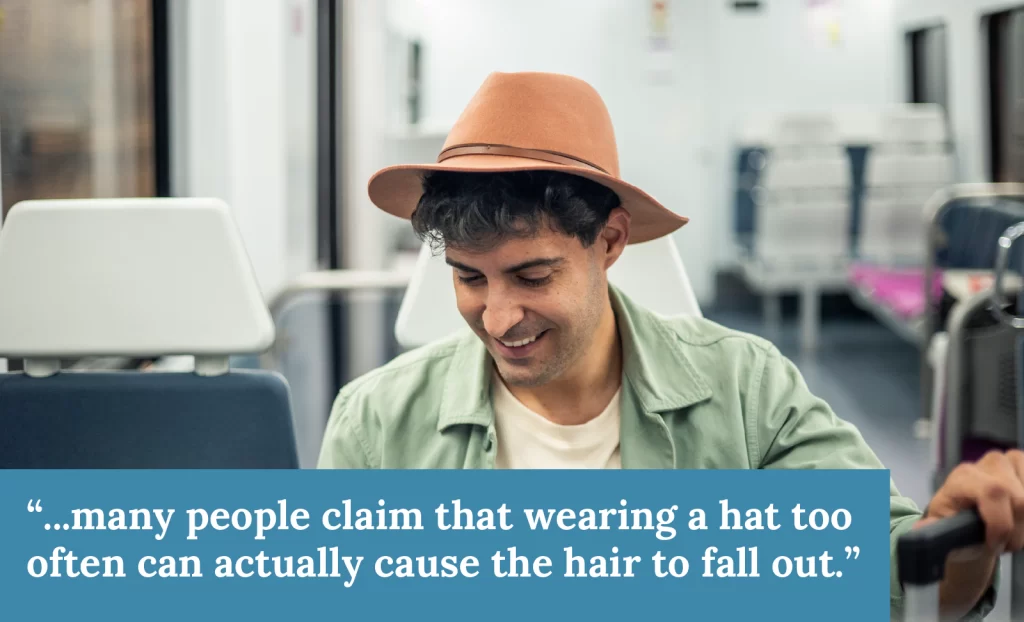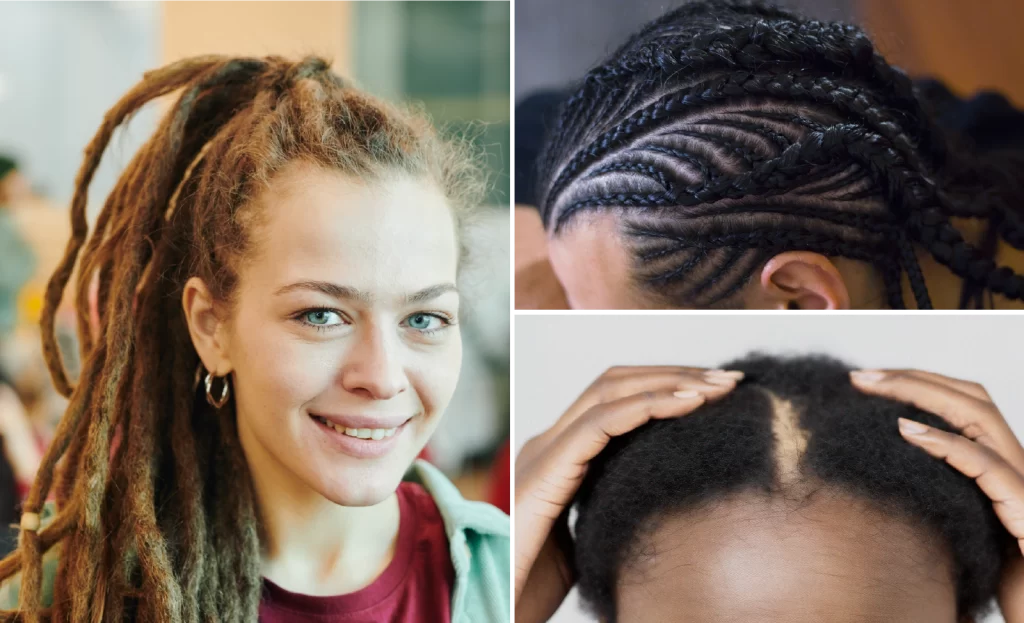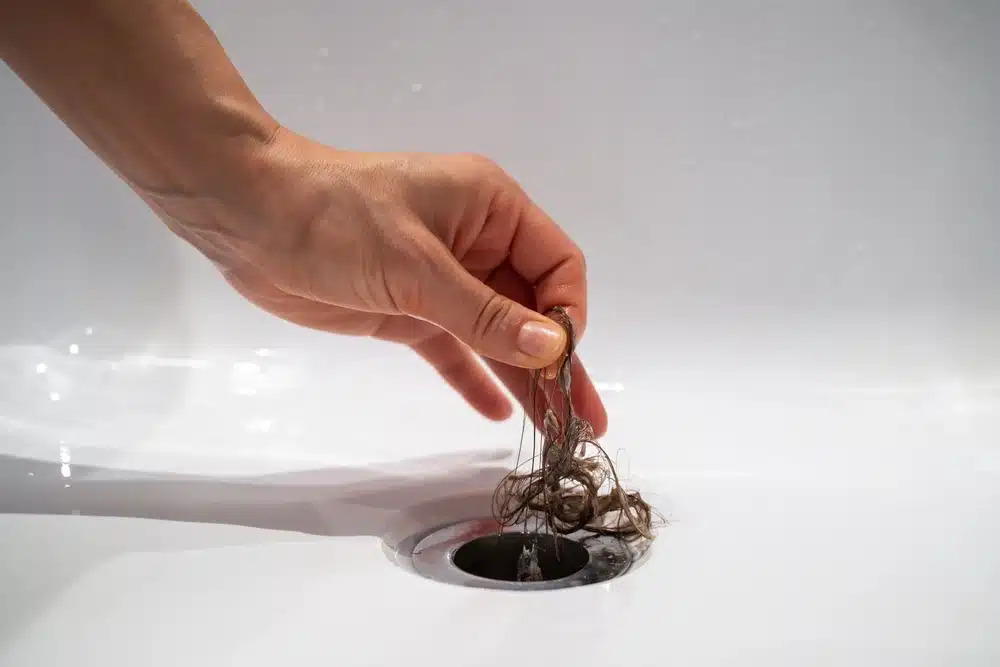Everybody has their own style. Some people like to accessorise with large bags, some enjoy dressing in bright colours, and others feel most comfortable while wearing a hat.
Wearing a hat every day may make some worry, though, as many people claim that wearing a hat too often can actually cause the hair to fall out. How much truth behind this is there, though – does hat wearing cause hair loss, or is it just a myth? Find out all you need to know below.
Does Wearing a Hat Cause Hair Loss?
Now, onto the question, “Does wearing a hat cause hair loss?”. The answer is not directly. Wearing a hat, even every single day, should not cause hair loss in most people. However, there is the exception of wearing a very tight hat that pulls too much on the hair roots. If this occurs over extended periods, the pressure can cause a type of hair loss called traction alopecia.
You don’t need to ditch the warming beanie, the stylish beret, or the cool baseball cap, however. Instead, ensure the hat fits comfortably and causes zero tension on your strands and roots to avoid damage.
Other Ways Hats May Damage Your Hair
It should be noted that traction alopecia is not the only way wearing a hat can get in the way of healthy hair – here are other ways it could damage your locks.
Friction: Wearing a hat on your head can cause friction between the hat’s material and your strands. In turn, this leads to frizz, split ends, and hair breakage. Keep in mind that some hat materials are worse for hair damage than others, such as synthetic materials like polyester, rough textures like straw, and coarse textures like wool.
Poor Hygiene: In some cases, wearing a hat excessively for long periods can cause poor hygiene, leading to a build-up of sweat, dandruff, and bacteria. Not only can this cause an unpleasant smell (on both the hat and the scalp), but this build-up can affect your scalp’s health, meaning the hair follicles aren’t in as good an environment to grow healthy hair.
Allergies: In rarer cases, wearing a hat may cause damage to your hair and scalp due to an allergy. Of course, this only happens if you have an allergy to the material of the hat, whether wool, felt, polyester, or leather. If you experience skin reactions like itching, a rash, redness, and swelling, that could indicate an allergy, and you should speak to your doctor.
Understanding Traction Alopecia
As mentioned, the main potential way hats cause hair loss is through traction alopecia, which occurs if the hat is too tight and pulls at the hair follicles.
Traction alopecia is a specific type of hair loss that is caused by repetitive pulling of the hair, which damages the hair follicles and causes the hair to fall out in that particular area. [1] The most common causes of traction alopecia include hairstyles such as tight braids, ponytails, dreadlocks, and hair extensions, but in rarer circumstances, wearing a tight hat can also cause it.
Most cases of traction alopecia are reversible, but it’s important to stop the hair-pulling, as, over time, the damage can become so severe that it is no longer reversible, meaning permanent hair loss.
The Signs of Traction Alopecia
Have you experienced hair loss after wearing a hat for a while? If so, you are likely worried you have traction alopecia, and it’s always best to treat it as soon as possible. So, here are the signs.
- Patches of Hair Loss
- Thinning Hair
- A Receding Hairline
- An Irritated Scalp
- Redness Around the Scalp
It should be noted that many of these signs overlap with other scalp and hair conditions, such as scalp psoriasis [2], androgenetic alopecia, and telogen effluvium. That’s why it’s best to consult a hair specialist or doctor if you notice hair loss of any kind.
Want to get in touch with the top hair specialists in the business? Download our hair track app.
Preventing Traction Alopecia When Wearing Hats
The good news is you never have to ditch your beloved hat (or full hat collection). There are many great reasons to wear hats, after all, from protecting your hair/scalp from environmental factors to enjoying your unique style to hiding a less-than-perfect hairdo.
It’s all about knowing how to prevent traction alopecia. The key here is to always pick a hat that sits comfortably on your head. It should never pull or tug at your strands – instead, it should sit in place without fear of it falling off but also without being overly tight. Most hats come with adjusters so you can achieve the correct size.
Treating Traction Alopecia
Most of the people asking will wearing a hat cause hair loss are likely those who have already experienced hair fallout. If you have traction alopecia, rest assured hope is not lost – oftentimes, there are ways to regrow your locks, particularly with the following treatments.
Stop Further Hair Loss: The best way to treat traction alopecia is by preventing further hair loss. This might mean stopping wearing a hat that is too tight for your head.
Minoxidil: Minoxidil is an effective topical medication available over the counter. It’s used to treat various types of hair loss by stimulating blood flow to the scalp, which encourages the follicles to grow new, healthy hair.
Corticosteroids: These are synthetic hormones (steroids) that you can apply topically. They work to stimulate new growth by reducing inflammation. While these are typically used to treat alopecia areata, they can also work for traction alopecia.
Low-Level Laser Therapy: Another way to stimulate the follicles is by getting a low-level laser therapy treatment. It’s a minimally invasive clinical procedure that targets your hair follicles with low-level lasers, which stimulate blood flow, creating a better environment for growth.
A Hair Transplant: For permanent hair loss caused by traction alopecia, the best treatment is undoubtedly a hair transplant. This is a minimally invasive surgical procedure that uses healthy hair follicles and plants them in the balding or thinning hair section. After a few months, brand-new hairs grow through, eliminating any bald patches.
Can Wearing Hats Actually Be Beneficial for the Hair?
The answer to, “Does wearing a hat cause hair loss?” is yes, sometimes, and this is due to traction alopecia. However, this doesn’t cover the fact that wearing a hat can actually protect your hair and scalp! That’s because a hat provides ample protection from UV rays, which could otherwise dry out your hair and even damage the scalp, leading to impaired hair follicles. So, in some circumstances – particularly when the sun is at its highest – wearing a hat is the better option.
Other Causes of Hair Loss
After asking, “Does wearing a hat cause hair loss?” and realising that your hat is likely not to blame, you may want to turn your mind to other common causes of hair loss.
Androgenetic Alopecia: This is one of the most common causes of hair loss in men and women, although it affects men more. This is a type of genetic hair loss that’s also referred to as pattern hair loss, causing symptoms such as a receding hairline and a thinning crown.
Telogen Effluvium: This is a type of hair loss caused by stress on the body. Various stressors can cause it, including rapid weight loss, high levels of stress, major surgery, or hormonal changes.
Certain Medical Conditions: There are several medical conditions that can lead to hair loss. These include autoimmune diseases (like alopecia areata), nutritional deficiencies, thyroid disorders, and lupus.
If you are unsure what is causing your hair loss, it’s always worth speaking to a professional. The first step to treating hair loss is understanding the root cause, after all. Once you know what’s contributing to your hair falling out, you can find the right hair loss treatment.
Does Wearing a Hat Cause Hair Loss: In Summary
So, does wearing hats lead to hair loss? In some cases where the individual chooses overly tight hats that pull at the hair roots, yes, it can cause traction alopecia. However, most people who wear hats will not experience this, and if you have noticed hair loss, the chances are another cause is to blame. That said, it’s always best to consult with a medical professional, especially if you do not know what is contributing to hair loss.
Are you interested in a permanent solution to your hair loss? Perhaps you are tired of your receding hairline or balding crown. With a FUE hair transplant, you can completely transform your locks and enjoy the results for a lifetime. If you want to learn more, get in touch with our incredible team of hair specialists. You can also head to our patients gallery where you’ll see exactly the results the FUE method can provide!
Sources:
- https://knowyourskin.britishskinfoundation.org.uk/condition/traction-alopecia/
- https://www.webmd.com/skin-problems-and-treatments/psoriasis/scalp-psoriasis





